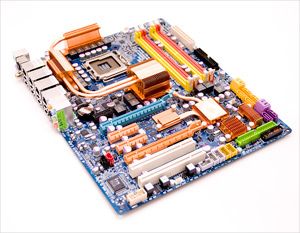Four-Way Gigabyte P45 Motherboard Round-Up
Gigabyte EP45-DQ6
High-End / Enthusist DDR2 - Gigabyte EP45-DQ6
So, you want a high-end Intel P45 motherboard, but don’t want to give up your previous DDR2 modules? Gigabyte has a board which might just be up your alley. Competing directly against the Asus's P5Q Premium and Maximus Formula II boards, Gigabyte is now shipping the EP45-DQ6 platform, which is their most expensive DDR2 platform based on the P45 chipset. Gigabyte was so proud of this platform that they actually flew a select group of journalists to Taiwan to look at it months before it was released. It’s quite a platform, although we’re not sure if it’s really worth all that fuss. It sure is nice, though!
 Gigabyte EP45-DQ6 |
 Gigabyte EP45-DQ6 |
Gigabyte might have well just called this motherboard the “Salute to copper”, as a large portion of the motherboard components are connected and cooled by various copper-based components. The primary cooling system runs down the center of the motherboard, which covers the Northbridge, Southbridge, and processor VRM components by a series of five heatpipes. Gigabyte’s SilentPipe heatsink allows for the (fairly-cool running) Intel P45 chipset to run silently and also allows for plenty of overclocking potential. Not satisfied with two truck tons of copper onboard, they also outfitted copper heat routing components to other Southbridge components, including their specially made SATA2 controllers and PCI Express bridge chip.
The PCI Express chip is an interesting addition, as it’s something we have not seen on other Intel P45 platforms. Basically, as Gigabyte has loaded up so many PCI Express based devices on this motherboard, they added on a dedicated PCI Express bridge chip to handle the load and route it properly through the chipset. Bridge chips are a fine interim solution for chipsets which don’t have enough lanes to support all the onboard devices necessary, although they do come at a price, namely heat production, latency, and power consumption.
Why does Gigabyte need a dedicated PCI Express bridge chip? Because, well, they have gone a little overboard--in a good way. A quick look at the motherboard’s I/O panel shows four (!) onboard Gigabit Ethernet ports, all of which connect to this bridge chip via PCI Express x1 connections. Gigabyte also has implemented their own custom SATA2 logic along with two Silicon Image “Steelvine” controller chips which connect via PCI Express, allowing for the board to handle a massive 12 (!!) Serial ATA-II RAID ports. Steelvine controllers allow for basic RAID-0 and RAID-1 arrays to be setup without driver installations, which make setup much easier for new users. With this much excess, it’s amazing that they were able to cram it all onto a standard ATX sized platform.
 Northbridge/VRM Cooling and 12-Phase Power |
 12 x SATA-II RAID Ports, Southbridge, PCIe Bridge |
Want more? Sure. This motherboard has two full-sized PCI Express 2.0 x16 sized slots (x16 and x8, which drop down to 8x8 for Crossfire multi-GPU systems), along with two additional PCI Express x4 slots and a PCI Express x1 slot. The PCI Express x4 slots are unique in that they are open-ended slots, which allow them to handle larger x8 and x16 cards if need be, albeit at lower bandwidth levels. These PCI Express x4 slots also connect to the onboard PCI Express bridge chip, rather than directly to the Intel chipset. The board also supports three Firewire 400 ports, 12x USB 2.0 ports, along with 8-channel analog/7.1 channel optical/digital S/PDIF digital sound system using Realtek’s ALC889A CODEC. The platform, like most of Gigabyte’s P45 lineup, is Dolby Home Theater certified.
The board supports up to 16 GB of DDR2 memory over 4 x slots, and Gigabyte officially supports DDR2 clock speeds up to 1200 MHz. The platform is also certified to handle front side bus speeds of 1600 MHz, but is capable of much more with a little tweaking. As the board supports (virtual) 12-phase power and Gigabyte’s Dynanic Energy Saver technologies.
Despite all of its fancy heatpipe cooling systems and 12-phase power system, in our tests we found the EP45-DQ6 to be a surprisingly poor overclocking board. The initial BIOS releases were downright terrible, not even allowing us to reach FSB speeds of over 400 MHz (1600 MHz). With the latest F10 BIOS, we were able to take our overclocking test CPU up to a maximum front side bus speed of 433 MHz (1733 MHz) FSB before instability issues started getting into the mix. Knowing what this CPU is capable of, we were highly disappointed at how little we could eek out of this CPU from this motherboard. Perhaps with so many onboard components, one of the other devices was showing itself to be less tolerant of high bus speeds and was failing out on us. Whatever the case is, our experience here was less than optimal in regards to overclocking.
With a street price of about $250, it’s definitely an expensive platform, but the EP45-DQ6 has a downright amazing feature set for a standard ATX sized motherboard. It actually feels worthy of this price tag, despite our lackluster overclocking experience. This is a P45 motherboard for those who want nearly every possible I/O and expansion feature possible, no matter what the cost. It’s definitely one of the most unique platforms Gigabyte has ever created, and should be considered for high-end buyers who don’t want to move up to DDR3 memory.






